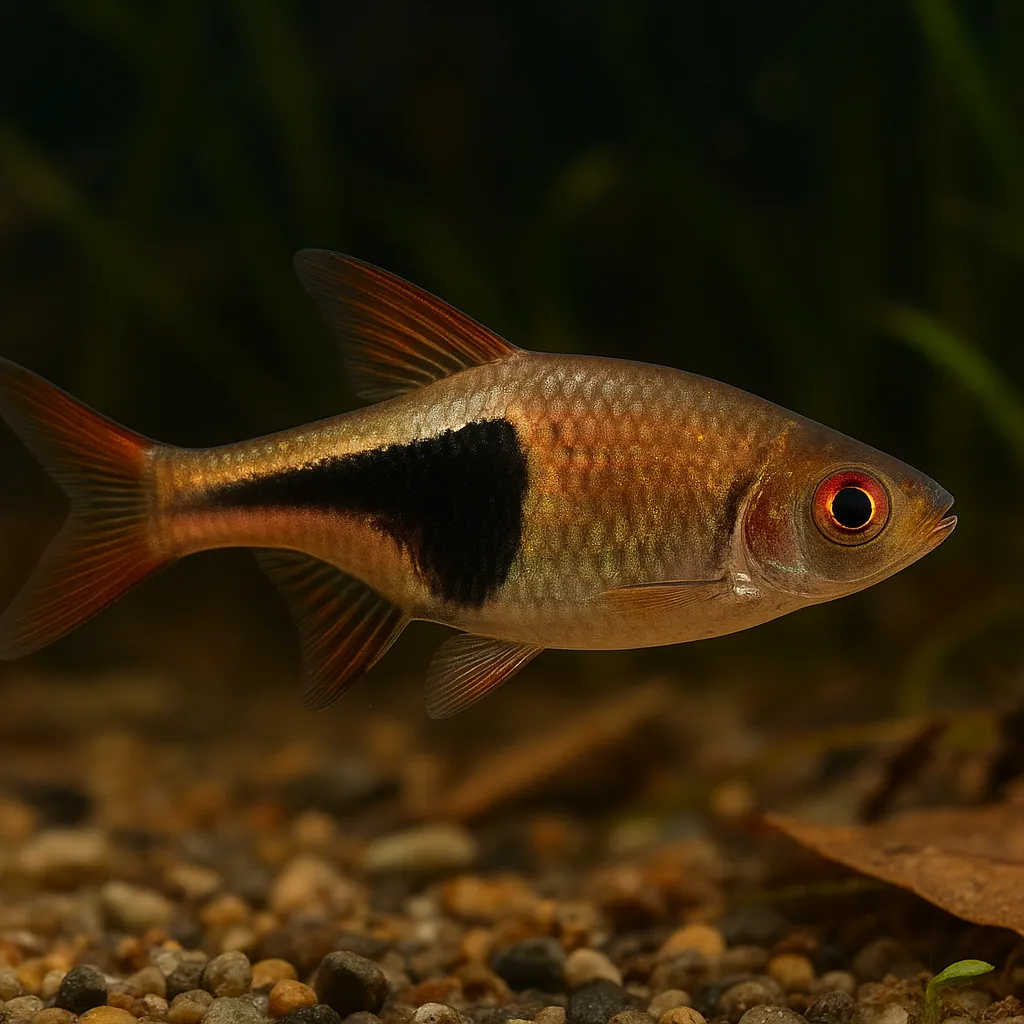
Harlequin rasbora
Introduction
The Harlequin rasbora (Trigonostigma heteromorpha) is a vibrant and peaceful freshwater fish, cherished by aquarists for its striking coloration and ease of care. Its shimmering copper-orange body, adorned with a distinctive black triangular patch, adds a splash of color to any aquarium. Ideal for both novice and experienced fishkeepers, the Harlequin rasbora thrives in community tanks and is known for its hardy nature.
What makes the Harlequin rasbora a popular choice among aquarists?
Its stunning appearance, peaceful temperament, and adaptability to various tank conditions make it a favorite among fish enthusiasts.
Is the Harlequin rasbora suitable for beginners?
Yes, due to its hardy nature and straightforward care requirements, it's an excellent choice for those new to fishkeeping.
Care and Environment
Providing optimal care for the Harlequin rasbora involves replicating its natural habitat and ensuring stable water conditions.
What is the minimum tank size for a Harlequin rasbora?
A minimum tank size of 38 liters is recommended to accommodate a small group, as these fish are social and thrive in schools.
What are the ideal water parameters for Harlequin rasboras?
Maintain a temperature between 22°C and 28°C, a pH of 6.0 to 7.8, and water hardness between 2 to 12 dGH. Consistent water quality is crucial for their health.
How should the tank be set up for Harlequin rasboras?
Use a dark substrate to mimic their natural environment and include live plants like Java fern, Anubias, and Cryptocoryne to provide hiding spots. Adding driftwood and dried leaves can introduce beneficial tannins, creating a blackwater effect that enhances their coloration and reduces stress.
What type of filtration and lighting do Harlequin rasboras prefer?
Opt for a gentle filtration system to avoid strong currents, as these fish inhabit slow-moving waters. Moderate lighting, possibly diffused by floating plants, will replicate their natural, dimly lit habitats.
What should be included in the diet of Harlequin rasboras?
As omnivores, they accept high-quality flake or pellet foods supplemented with live or frozen options like brine shrimp, daphnia, and bloodworms. Feeding small amounts twice daily prevents overfeeding and maintains water quality.
Are there any specific challenges in caring for Harlequin rasboras?
They can be sensitive to sudden changes in water parameters. Regular monitoring and gradual adjustments are essential to prevent stress and health issues.
Origin and Habitat
Native to Southeast Asia, the Harlequin rasbora is found in countries like Thailand, Malaysia, and Singapore. They inhabit slow-moving streams, swamps, and peat bogs, often in areas with dense vegetation and soft, acidic waters. The presence of leaf litter and decaying plant matter in these environments contributes to the blackwater conditions they favor.
What type of water bodies do Harlequin rasboras naturally inhabit?
They are commonly found in slow-moving streams, swamps, and peat bogs with dense vegetation.
How do their natural habitats influence their care in aquariums?
Replicating their natural environment with soft, acidic water, dense planting, and subdued lighting helps them thrive in captivity.
Temperament and Compatibility
Harlequin rasboras are peaceful, schooling fish that prefer to be kept in groups of at least six to exhibit natural behaviors and reduce stress. They are ideal for community tanks with other non-aggressive species.
What are suitable tank mates for Harlequin rasboras?
Compatible companions include small tetras, other rasbora species, Corydoras catfish, and peaceful shrimp like Amano shrimp.
Are there any fish species to avoid housing with Harlequin rasboras?
Avoid larger or aggressive species that may intimidate or prey on them, such as large cichlids or aggressive barbs.
How can a harmonious tank community be created with Harlequin rasboras?
Ensure all tank mates share similar water parameter requirements and temperaments, and provide ample space and hiding spots to reduce territorial disputes.
Interesting Facts
The Harlequin rasbora has been a staple in the aquarium trade since the early 20th century, admired for its resilience and beauty. In the wild, they exhibit unique breeding behaviors, with females depositing eggs on the undersides of broad leaves. This species is also known for its synchronized swimming patterns, creating a mesmerizing display in well-maintained aquariums.
What is unique about the breeding behavior of Harlequin rasboras?
Females lay eggs on the undersides of broad leaves, and both parents may guard the eggs until they hatch.
How long have Harlequin rasboras been popular in the aquarium trade?
They have been cherished by aquarists since the early 20th century for their beauty and hardiness.
Do Harlequin rasboras exhibit any special behaviors in aquariums?
They are known for their synchronized swimming patterns, especially when kept in larger schools, creating a captivating display.
Sources
All information in this article has been gathered from the following reputable sources:
Overview
Recommended Tank Size 20.1 Gallons (for groups of 6 or more) |
Minimum Group Size 6 |
Minimum Tank Volume 10 Gallons |
Maximum Adult Length 1.8 inches |
Average Adult Length 1.4 inches |
Shoaling (6+ required) Yes |
Preferred Water Type Soft, acidic freshwater |
Temperature Range (°C) 22–28 |
pH Range 6.0–7.8 |
Water Hardness (dGH) 2–12 |
Typical Lifespan (years) 5 years |